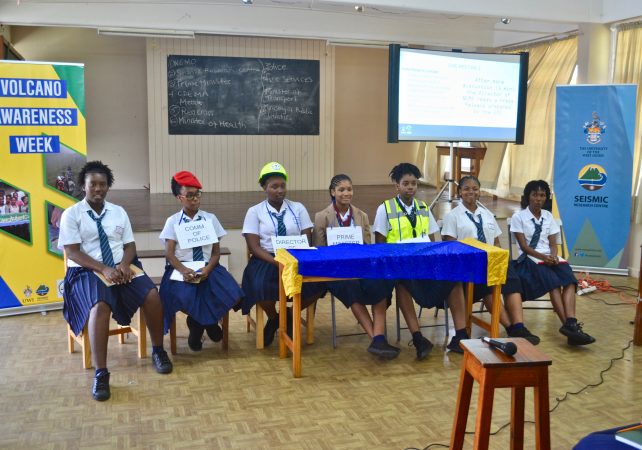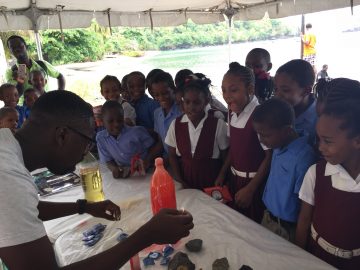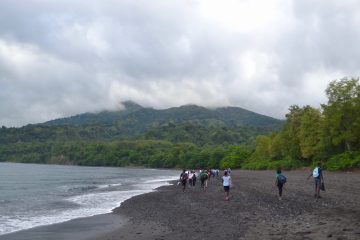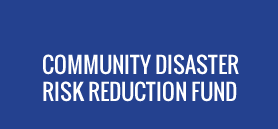The National Emergency Management Organization (NEMO) of St. Vincent and the Grenadines, in partnership with The UWI Seismic Research Centre (SRC), hosted Volcano Awareness Week to increase communities’ knowledge of volcanic hazards and related emergency preparedness and crisis response measures. The week of fun and engaging activities was held to commemorate the 39th anniversary of La Soufriere eruption and aid in the implementation of the recently launched Volcano Ready Communities Project (VRCP). The VRCP aims to raise awareness of volcano and multi-hazards risk, and to enhance the adaptive capacity of communities in St. Vincent and the Grenadines. It is being implemented by the SRC and is financed through the Caribbean Development Bank’s Community Disaster Risk Reduction Fund (CDRRF), which is a multi-donor trust fund supported by the Government of Canada and the European Union.
The week kicked off with “Disaster Duty”, an Emergency Operations Centre (EOC) Scenario Workshop for 120 Form 4 Geography students at the St. Vincent Grammar School and Girls High School. Students were engaged in a role-playing scenario exercise where they communicated essential information on volcanic hazards and their impact, and learned about the importance of preparedness as well as how to manage crisis situations. Each group was required to play the role of the EOC, which would typically include the Prime Minister, Disaster Manager, Scientist and Commissioner of Police. The engagement has potential for wider and longer-lasting impact as students from both schools have historically become future leaders in the wider society.

Students at the St. Vincent Grammar School and Girls High School participate in disaster emergency role-playing sessions as part of Volcano Awareness Week.
Following this activity, the VRCP team travelled to the Chateaubelair Community Centre to mount and showcase the Soufriere Blow Exhibition, which was developed in collaboration with the SRC, NEMO and several institutions in the United Kingdom, including the University of East Anglia and the British Geological Survey. The exhibition was the focal point for engagements over the next three days with primary schools, secondary schools and community members in the north leeward areas of St. Vincent and the Grenadines. The exhibition included a model volcano structure featuring scientific and cultural information as well as accounts of historical experiences related to the 1902 and 1979 eruptions of La Soufriere Volcano.
To complement the exhibit, two short films produced on the volcanic hazard in St. Vincent and the Grenadines were screened and students were engaged in discussions on the films’ content. They then participated in two practical experiments to highlight the scientific phenomenon of volcanic eruptions.

Students participating in practical experiments to highlight the scientific phenomenon of volcanic eruptions.
Students from the Chateaubelair and Fitz Hughes Primary Schools were invited to participate in the exhibition and workshops, along with Geography students from the Petit Bordel and Troumaca Secondary Schools. Both schools are attended by children from north leeward communities of the island, including Chateaubelair, Fitz Hughes and Rose Hall, three of the 12 communities targeted by the VRCP.
Continuing the week’s activities, a field trip was also conducted with Geography students of the Petit Bordel and Troumaca Secondary Schools. After the students viewed the exhibit, Geologist and SRC Director, Professor Richard Robertson, led them on a guided tour of the area. The objective of this activity was to highlight key aspects of the geology and geography of Chateaubelair that illustrate and relate to the multi-hazard environment. A structured and guided treasure hunt also served to pique curiosity and engage students in discovering the scientific explanations for their surrounding landscape.
A community meeting was also held to highlight and engage stakeholders of the Volcano Ready Communities Project (VRCP). It served as an opportunity to sensitize the public to the multi-hazard volcanic environment in which they are situated, and to the importance of volcano readiness, and how this relates to the engagements planned throughout the project. The activity also provided a forum for members of the community to share their experiences with volcanic and other hazards affecting their community.
Volcano Awareness Week culminated in a community and student hike to La Soufriere Volcano. Beginning with a brief overview of the volcano and its past activity, this event provided an ideal opportunity to further improve public awareness of the volcanic environment. It was led by a team comprising staff from the SRC, NEMO, Soufriere Monitoring Unit and the Forestry Department.

Volcano Awareness Week culminated in a community and student hike to La Soufriere Volcano.




